|
|
 |
|
 |
| |
Publisher:
Chairman Sheng-Lung Huang Editors:
Prof. Jui-che Tsai, Ms. Hsiao-wen Lin July 30,
2010 |
| |
|
 |
|
March “Photonics Forum”
Lecture Highlights |
|
|
March 9th, 2010 (Tuesday)
4:30 PM |
|
Speaker: |
Professor Chinlon Lin
(Nanyang
Professor, Director of Photonics
Research Center, School of EEE,
Nanyang Tech. University, Singapore) |
|
Topic: |
From G. Marconi to Charles K.
Kao--100 Years of Nobel Prize
(Physics, 1909-2009) and A Century
of Modern Marvels of EECS |
| |
Professor
Chinlon Lin
visited GIPO on March 9th
(Tuesday) and lectured in Auditorium
101, Barry Lam Hall. His lecture,
“From G. Marconi to Charles K.
Kao--100 Years of Nobel Prize
(Physics, 1909-2009) and A Century
of Modern Marvels of EECS” was
attended by GIPO professors and
students with enthusiasm. Everyone
learned much. |
|
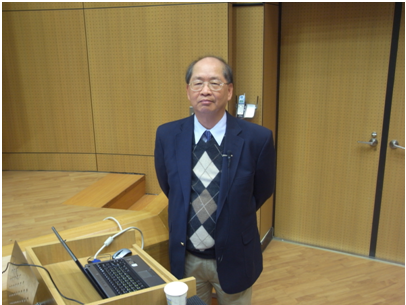 |
|
Speaker, Professor
Chinlon Lin |
|
|
March 12th, 2010 (Friday)
2:30 PM |
|
Speaker: |
Prof.
Stephen E. Saddow
(Professor of
Electrical Engineering, University
of South Florida) |
|
Topic: |
Silicon Carbide: A Robust
Semiconductor Material for Harsh
Environment MEMS and Biomedical
Applications |
| |
Professor Stephen E. Saddow attended
the GIPO Photonics Forum on March 12th,
2010 (Friday). GIPO professors and
students who attended his lecture
“Silicon Carbide: A Robust
Semiconductor Material for Harsh
Environment MEMS and Biomedical
Applications” participated with
enthusiasm. Professor Saddow’s
lecture was fascinating and
thorough, and he interacted with his
audience throughout the lecture. |
|
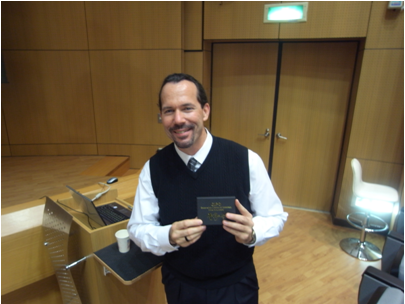 |
|
Speaker, Professor
Stephen E. Saddow |
|
|
March 26th, 2010 (Friday)
2:30 PM |
|
Speaker: |
Director-general Zhu-Shun
Zhuo of Value Creation
Center, Wistron Corporation |
|
Topic: |
The Transformation and Development
of the Photonics and Information
and Communication Industries |
| |
Director-general Zhu-Shun Zhuo
visited GIPO on March,
26th,
2010 (Friday) to speak at GIPO’s
Photonics Forum. His lecture, “The
Transformation and Development of
the Photonics and Information and
Communication Industries” was attended
with enthusiasm by GIPO professors
and students. Director-general Zhu-Shun
Zhuo’s lecture was both informative
and fascinating and he interacted
with his audience throughout the
lecture. Everyone who attended
learned much. |
|
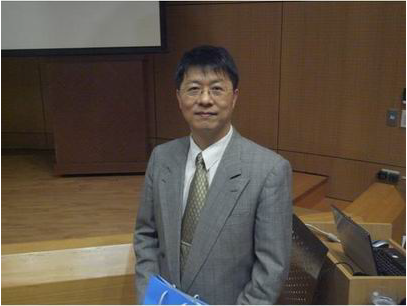 |
|
Speaker,
Director-general Zhu-Shun Zhuo |
|
April
“Photonics Forum”
Lecture Highlights |
|
|
April 16th, 2010 (Friday)
2:30 PM |
|
Speaker: |
Professor Wood-Hi Cheng
(Department of
Photonics, National Sun Yat-Sen
University) |
|
Topic: |
A Work of Art:
The
Research and Development of Optical
Fiber Lens |
| |
Professor Wood-Hi Cheng visited GIPO
on April 16th (Friday)
and lectured in Auditorium 101,
Barry Lam Hall. His lecture,
“A Work of Art:
The
Research and Development of Optical
Fiber Lens”
was attended with enthusiasm by GIPO
professors and students, and
everyone learned much from the
lecture. |
|
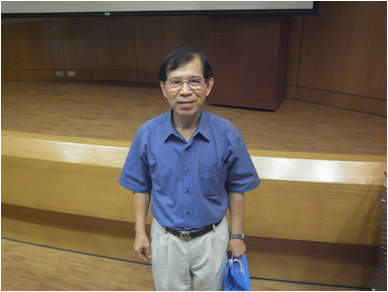 |
|
Speaker, Professor
Wood-Hi Cheng |
|
May
“Photonics Forum”
Lecture Highlights |
|
|
May 7th, 2010 (Friday)
2:30 PM |
|
Speaker: |
Professor
Chi-Shun Tu (Graduate
Institute of Applied Science and
Engineering, Fu-Jen Catholic
University) |
|
Topic: |
Multiferroics and Solid Oxide Fuel
Cell |
| |
Professor Chi-Shun Tu visited GIPO
on May 7th (Friday) and
lectured in Auditorium 101, Barry
Lam Hall. His lecture “Multiferroics
and Solid Oxide Fuel Cell” was
attended with enthusiasm by GIPO
professors and students. |
|
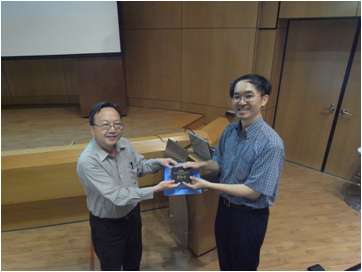 |
|
The host of the lecture, Professor Zhe-Chuan
Feng (left) pictured with Professor
Chi-Shun Tu (right). |
~ Small-scale Drill for Emergency, Ming-Da
Hall, EECS ~
(Time: March 30th, 2010; Location:
Ming-Da Hall, EECS, NTU)
Composed
by: Tzu-Yu Chen
GIPO and GIBEBI (Graduate
Institute of Biomedical Electronic and
Bioinformatics) held a small-scale drill
for emergency at Ming-Da Hall to ensure
that staff developed sufficient skills
to deal with emergency situations, and
are able to provide immediate
assistance, minimizing possible losses.
This exercise also served to familiarize
participants with important concepts in
safety and emergency management,
increasing everyone’s ability to deal
with such situation.
On the morning of March
30, 2010, experts from Der-An
Engineering Consultants, Inc., were
invited to give a lecture concerning
fire-fighting skills and facilities to
our teachers, staff and students. This
was done to increase everyone’s
knowledge on this topic. Next, a drill
for emergency took place: a simulated
fire occurred in laboratory 703, on the
7th floor as students were performing
research. An extension cord caught fire,
and the resulting smoke triggered the
smoke detector and fire alarms in Ming-Da
Hall. The laboratory immediately
reported the situation to the control
center on the 3rd floor, to the campus
police squad, and to the chairman of
GIPO. Fire-fighting and defense units
were formed immediately, including a
command unit, an information unit, a
fire-extinguishing unit, an evacuation
assistance unit, a safety unit, and a
rescue unit. These teams quickly began
to carry out their individual missions.
The drill was completed when all
personnel in the building had been
evacuated and assembled in the square on
the ground floor.
After the drill, the
experts from Der-An Engineering
Consultants, Inc. demonstrated the use
of fire extinguishers, and participants
practiced with fire extinguishers, the
fire hydrants and the rescue descending
devices. Through these hands-on
experiences, we not only learned how to
use the facilities, but also improved
our ability to escape from dangerous
situations.
We would like to take
this opportunity to thank all the
participating teachers, staff and
students for your kind cooperation. It
is our hope that after this experience,
we will all pay more attention to
building safety and, when accidents do
occur, immediately report the danger to
the appropriate units and take measures
to control the damage.
|
A lecture on lab safety and fire
extinguishing facilities. |
After the fire broke out, a command
zone, a rescue zone, an assembly
zone were formed immediately. |
|
The broadcasting unit proceeded to
announce the danger in the building. |
The evacuation assistance unit
evacuating personnel on the spot. |
|
Experts teaching participants how to
use fire extinguishers after the
drill. |
Participants using the descending
devices after the drill. |
~ The
2nd GIPO Students' Association Badminton Tournament ~
(Time: May 30, 2010;
Location: the multi-function court, 1F, NTU Sports Center)
Composed by:
Hsiang-Chun Wei, the President of the GIPO Students' Association
The 2nd
GIPO badminton tournament has drawn to a
successful close, and we’d like to thank
everyone for their enthusiastic
participation. There were 15 singles and
14 doubles teams participating, and
prizes were plentiful. We had a
champion, a second place and 2 third
places for the singles and doubles
categories. The tournament was held at
the 1F multi-function court of NTU's
Sports Center, at 10:30 AM on May 30th.
Every game was intensely played.
Finally, Agnes Lee won the singles
champion, with Wei-Chung Chen winning
second place, and Ying-Yuan Huang and
Yang-Kai Wu winning third. Yu-Ta
Wang/Agnes Lee won the doubles champion,
with Wei-Hsiuan Tseng/Po-Sheng Wang
winning second, with Guan-Jung
Lai/Yang-Kai Wu and Jeng-Wei Yu/Wei-Ting
Hu in third place. This year's
championship match was as exciting to
watch as last year's, and as the battle
progressed, spectators became more and
more excited as well.
From
this tournament, one can see that GIPO
is full of talent; our students are
gifted in many respects, and stay in
shape while studying hard. Regrettably,
there were no professors participating
in this year’s event. Perhaps, in future
tournaments, we could arrange matches
for professors so that they can enjoy
the event with us. There were perhaps
some things concerning this event that
could have been improved, and so we’d
like to thank you for your kind
cooperation.
We
would like to give special thanks to
those who have helped make this event
possible, including: Li-Chi, Wei-Ting,
Tzu-Yu and Hsiao-Wen of GIPO staff, and
our classmates Hsiao-Yuh Wang and
Jay-Zway Hong. We would also like to
thank Yu-Ming and Jia-Ning of my lab for their
invaluable advice. Also, thank you to
the participants who took on the job of
managing the score board. Finally, thank
you to our GIPO chairman for your kind
encouragement and financial support
which gave us sufficient funds to hold
this event.
|
 |
 |
|
Game schedule, singles |
Game schedule, doubles |
|
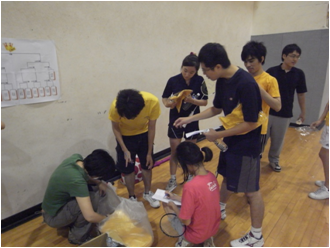 |
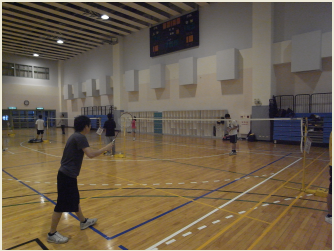 |
|
Check-in in the morning |
A singles match |
|
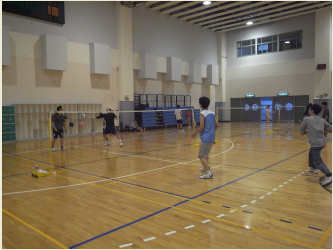 |
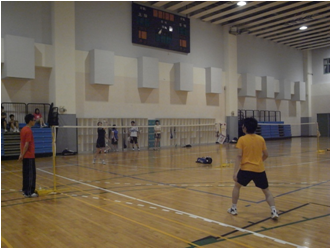 |
|
A doubles match |
The intense singles championship
match |
|
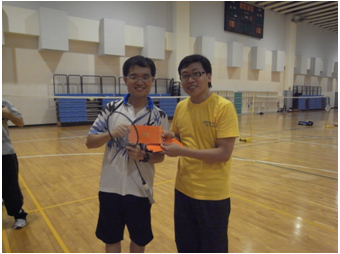 |
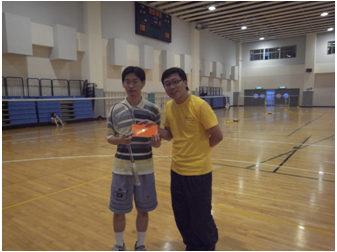 |
|
Awarding - third place, singles:
Ying-Yuan Huang (left) |
Awarding - third place, singles:
Yang-Kai Wu (left) |
|
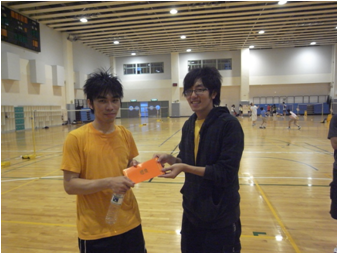 |
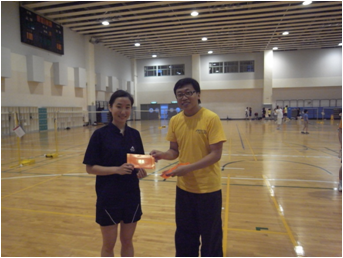 |
|
Awarding - second place, singles:
Wei-Chung Chen (left) |
Awarding - champion, singles: Agnes
Lee (left) |
|
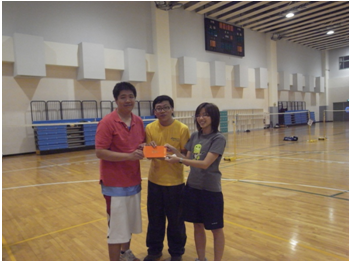 |
 |
|
Awarding - third place, doubles:
Jeng-Wei Yu (left) / Wei-Ting Hu
(right) |
Awarding - third place, doubles:
Guan-Jung Lai (middle) / Yang-Kai Wu
(right) |
|
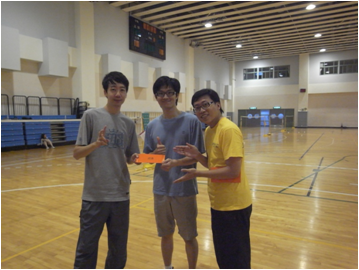 |
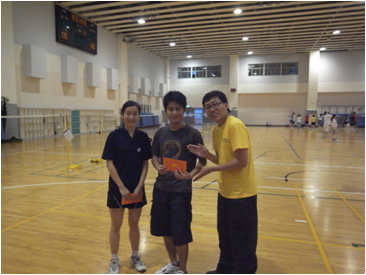 |
|
Awarding - second place, doubles:
Wei-Hsiuan Tseng (left) / Po-Sheng
Wang (middle) |
Awarding - champions, doubles: Agnes
Lee (left) / Yu-Ta Wang (middle) |
|
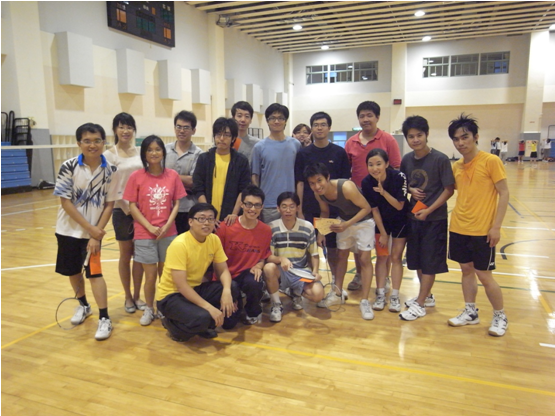 |
|
All participants, at the 2nd GIPO
Students’Association Badminton
Tournament closing ceremony |
|
 |
|
 |
|
| |
|
 |
~ 13th
International Conference on Phonon Scattering in Condensed Matter ~
(Time: April 18th ~ 23rd 2010; Location: Barry Lam
Hall, NTU)
Composed by: Chia-Hsun Chiao
GIPO
Professor
Chi-Kuang Sun
hosted the
13th International Conference on Phonon Scattering in
Condensed Matter on April 18th-23rd, 2010. There
were over 300 professionals and scholars from 21 countries attended the
conference. Professors and students of GIPO, the EE department, and the
physics department were also admitted to attend the lectures. In
addition to providing an opportunity for scholars from different
countries to share their newest research developments, we believe that
sponsoring this conference allows other countries to better understand
the level of research in Taiwan. Thus, this conference was an important
occasion for international cooperation.
The
International Conference on Phonon Scattering in Condensed Matter is not
only an international conference with excellent traditions and a long
history, but is also a flagship conference in phonon science. It has
been almost 40 years since the first conference was held at Saint-Maxime,
France, in 1972. Since then, it has been held once every 3 years, in
France, Germany, USA, Japan, UK and Russia respectively. Aside from the
aforesaid long history, it is also the most important occasion for
academic exchange in phonon research. The world’s most prominent
scholars regard this event as the most influential of conferences. The
topics discussed in previous conferences comprehensively covered phonon
sciences, and included experiments, theories and numeral simulations.
Thus, it can be seen that this event is an authoritative and
representative conference.
This year,
Professor Sun hosted the conference, which began on April 18, and ended
on April 23, lasting 6 days. There was a tutorial talk, 5 plenary talks
and 14 invited talks. From over 250 submissions, we selected 91 pieces
for oral presentation and 157 pieces for poster presentation. In
addition to publishing the conference proceedings, we also worked with
the Physical Society of Republic of China (TAIWAN) and have arranged a
special issue for the conference in the Chinese Journal of Physics. So
far, we have received and are reviewing near one hundred submissions.
Due to the volcanic eruption in Iceland, European flights fell to
disarray, and some European scholars were unable to attend the
conference personally. However, under Professor Sun’s direction,
we were
able to install a web-conferencing system a day before
the conference took place. These measures made it possible for stranded
scholars to participate in the conference through the internet. Our
solution effectively resolved the difficult situation, and conference
participants appreciated our facility in dealing with the contingency.
This unexpected development has also made this 13th
conference the 1st in the conference history to proceed via
the internet.
Aside from
inviting world scholars to deliver speeches, we had also hoped to
utilize the six days of the conference to increase recognition of NTU
internationally, and hoped to raise its internationalization level.
During the conference, Professor Sun introduced NTU's history and
heritage, its academic standing in Taiwan, and its current
international cooperative research projects. It was arranged for some
conference participants to visit NTU campus, hospital, and optics
laboratories. During the conference, we also worked with French scholars
to perform research, which certainly promoted academic interaction
between the two countries. The conference banquet was held at National
Taiwan Museum; this event allowed conference participants an opportunity
to relax and interact, and also introduced to international scholars
Taiwan’s aboriginal history and culture. Also, to allow conference
participants to experience Chinese cultural heritage and Taipei's
multi-faceted lifestyle, we also arranged visits to the National Palace
Museum and introduced several of Taipei's famous landmarks, such as
National Chiang Kai-shek Memorial Hall, the Grand Hotel and the Taipei
101.
This is the
first time that this influential conference was ever held in Taiwan, and
only the second time it was held in Asia. With the successful completion
of this conference, we have, in both the pre-conference preparation and
in the conference itself, showed the world Taiwan's technological
strength and advancement during this generation. Since phonon phenomenon
covers a wide range of subjects, from fundamental science to applied
technology, the success of this conference could indeed unify Taiwan's
phonon research projects and inspire Taiwan's scholars to connect
further with the world technology trends. In addition, the working staff
of this conference has also gained a lot of valuable experiences, and
thus, we will do an even better job for future international
conferences.
|
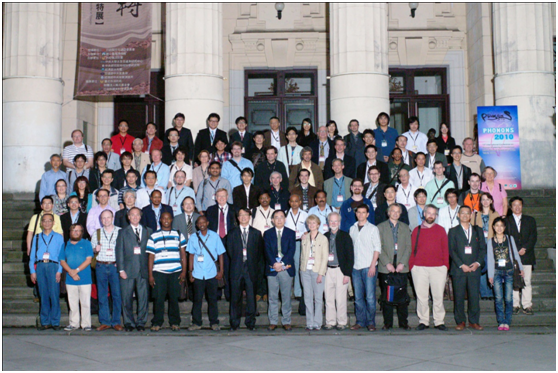 |
|
A group photo of the international
scholars |
|
|
|
 |
|
 |
|
| |
|
 |
|
Research
Accomplishments in 2009, Wide Gap
Semiconductor Laboratory
Professor
Zhe-Chuan Feng
Graduate Institute of Photonics and
Optoelectronics, National Taiwan
University
l“Raman
scattering study on anisotropic property
of wurtzite GaN”,
Hung Chiao Lin,
Z.C. Feng,
et al., JOURNAL OF APPLIED
PHYSICS 105, 036102 (2009)
l“Temperature
dependent and time-resolved
photoluminescence studies of InAs
self-assembled quantum dots with InGaAs
strain reducing layer structure”,
Lingmin Kong, Zhe Chuan
Feng, et al.,
JOURNAL OF APPLIED PHYSICS 106,
013512 (2009)
l“Suppression
of phase separation in InGaN layers
grown on lattice-matched ZnO substrates”,
N. Li, … Z.C. Feng, et al.,
Journal of Crystal Growth
311 (2009) 4628–4631.
l“Rapid
thermal annealing effects on the
structural and optical properties of ZnO
films deposited on Si substrates”,
Y.C. Lee, … Z.C. Feng, et al.,
J. Luminescence 129
(2009) 148–152.
l“Metalorganic
chemical vapour deposition of GaN layers
on ZnO substrates using
α-Al2O3
as a transition layer”,
S.J. Wang, … Z.C. Feng, et al.,
J. Phys. D: Appl. Phys.
42 (2009) 245302 (5pp).
l“Temperature-Dependent
Excitonic Luminescence in ZnO Thin Film
Grown by Metal Organic Chemical Vapor
Deposition”,
Y.C. Lee, … Z.C. Feng, et al.,
Japanese Journal of
Applied Physics 48 (2009) 112302.
Enhancing
InGaN-based solar cell efficiency
through localized surface plasmon
interaction by embedding Ag
nanoparticles
Professor Yean-Woei
Kiang's Laboratory
Graduate Institute of Photonics and
Optoelectronics, National Taiwan
University
We have demonstrated the
simulation results of using the
interaction of metal NP induced LSP with
an InGaN absorbing layer for enhancing
the efficiency of an InGaN/GaN-based
solar cell. The absorption increase is
implemented by embedding Ag NPs in InGaN
for inducing LSP. The effective LSP
absorption and NP scattering lead to the
enhancement of InGaN absorption. The
embedment of metal NPs in semiconductor
may affect carrier transport. However,
we show that such an effect is small
unless the surface recombination
velocity at the interface between a
metal NP and surrounding InGaN is
extremely high. Fig. 1 shows the photon
absorption rates (the left ordinate) of
the InGaN layer and Ag NP and the
short-circuit current densities (the
right ordinate) of the solar cell as
functions of wavelength for the cases
with and without Ag NP when the surface
recombination velocity, S, is 10
m/s. For comparison, the incident photon
flux under the condition of AM1.5G (the
curve labeled by “incidence”) is also
plotted in Fig. 1. The significant
absorption enhancement on the
long-wavelength side by embedding the Ag
NP can be clearly seen. In Fig. 1, the
curve labeled by “metal dissipation”
represents the part of photons absorbed
by the Ag NP and turned into dissipation
heat. The embedment of the Ag NP results
in an increase of integrated photon
absorption rate by 28.44 %. The two
curves of short-circuit current density
(per unit spectral width), i.e., JSC
(without NP) and JSC (with
NP), which essentially follow the
oscillatory behaviors of the two curves
for InGaN absorption show the
enhancement of photo-generated current.
With the embedded Ag NP, the integrated
JSC is increased by 27.87 %.
Fig. 2(a) shows the distribution of
electrical field magnitude at 580 nm in
the region around the Ag NP by assuming
that the magnitude of the incident field
is unity. Here, one can see that strong
near field is generated around the Ag
NP. Also, certain backscattered field is
distributed in the n-GaN layer. Fig.
2(b) shows the stream line distribution
of static electric field inside the
solar cell. Here, one can see the
distortion of static electric field by
the embedded Ag NP. Fig. 3 shows the
integrated current densities (the left
ordinate) and the output power densities
(the right ordinate) as functions of
applied voltage for the cases with NP
and without NP corresponding to the
results shown in Fig. 1. The first and
second numbers in the parentheses
represent the voltage for the maximum
output power (in V) and the maximum
output power density (in mW/cm2).
Here, one can see that the open-circuit
voltage of ~1.51 V is not affected by
the embedment of the Ag NP. The
integrated current density, J, is
significantly increased from 8.08 to
10.17 mA/cm2 by embedding the
Ag NP. The maximum output powers of both
cases are achieved at 1.4 V in applied
voltage. The maximum output power is
increased from 10.59 to 13.53 mW/cm2
(roughly from 10.59 to 13.53 % in
efficiency), corresponding to an
increase of 27.76 %.
Flexible
ZnO transparent thin film transistor
using solution-based process
Professor Ching-Fuh
Lin
Graduate Institute of Photonics and
Optoelectronics, National Taiwan
University
Currently, transparent electronics based
on a flexible substrate are one of the
most crucial technologies for the next
generation of optoelectronic devices,
such as displays, home electronic
appliances, and photovoltaics. Hence,
transparent thin-film transistors (TFTs)
on flexible substrates are key devices
for realizing these transparent
electronic products. Although organic
TFT and its manufacturing process are
suitable for flexible substrates, their
low mobility and extreme sensitivities
to oxygen and moisture overshadow their
device performance attributes. TFTs that
use ZnO have the advantages of high
charge mobility, excellent environmental
stability, and high transparency, in
comparison to TFTs that are based on
organic semiconductors.
In this
study, we have fabricated a highly
transparent ZnO-TFT by a hydrothermal
method using a polymeric PMMA film as
the gate insulating film. An O2-plasma
treatment was applied to the PMMA
dielectric to enhance compatibility
between the ZnO active layer and the
PMMA dielectric at the interface. In
order to investigate the effects of
grain boundaries on the flexible
ZnO-TFTs, we studied ZnO-TFTs that had
three kinds of ZnO channel morphologies,
which grew for 50 min at ZnO solution
concentrations of 110, 80, and 50 mM,
respectively. The field effect mobility
(μ) and threshold voltage (VT)
values were calculated from the slope of
a plot of the square root of the
drain-source current (IDS)
versus the gate voltage (VG)
in the regime of the drain-source
voltage (VDS)=20 V, using the
equation IDS= (WCi/2L)μ(VG-VT)2.
The saturation mobility was highest at
7.53 cm2/Vs for the 110 mM
preparation and lowest at 0.097 cm2/Vs
for the 50 mM preparation, with 0.69 cm2/Vs
for the 80 mM preparation.
|
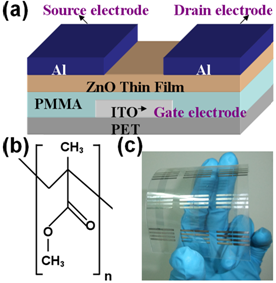 |
|
Fig. 1. (a)
Schematic illustration of the
ZnO-TFT device structure. (b) The
chemical structure of the PMMA. (c)
Photograph of the ZnO-TFT. |
|
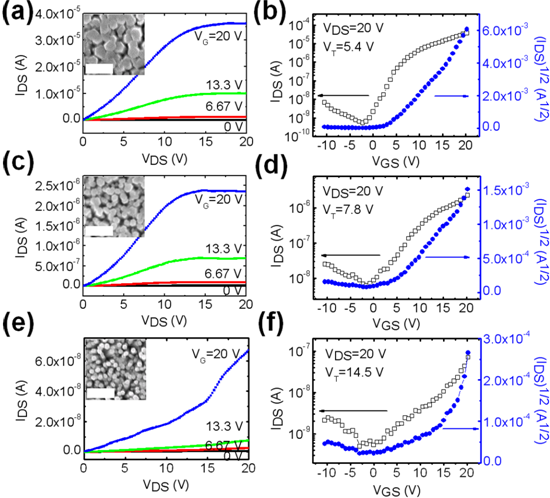 |
|
Fig. 2.
Transistor output curves for
ZnO-TFTs, fabricated with the ZnO
solution concentration at (a) 110 mM,
(c) 80 mM, and (e) 50 mM.
Corresponding transistor transfer
characteristics are (b) 110 mM, (d)
80 mM, and (f) 50 mM. The inset
shows the corresponding FESEM
images. The scale bar is 500 nm. |
Enhancements of direct band radiative
recombination from Ge
Professor
Chee-Wee Liu's group
Graduate Institute of Photonics and
Optoelectronics, National Taiwan
University
Due to
the high carrier mobility, strong photon
absorption, and possible integration
with Si, the indirect band gap Ge is
used for both scientific interest and
optoelectronic applications. The methods
to enhance the direct bandgap transition
include the high pumping level, the
elevated temperature, the high
concentration of n type doping, and the
biaxial tensile strain. Significant
enhancement of direct transition
fraction in both photoluminescence (PL)
and electroluminescence (EL) is
demonstrated. The physical recombination
models are developed for both direct and
indirect transitions.
Fig. 1 and Fig. 2 show the PL infrared
emission from the n+p Ge
structure. The electrons in Γ valley and
L valley recombine with holes in the
valence band and emit infrared at the
795meV peak (direct bandgap transition)
and the 695meV peak (indirect bandgap
transition), respectively. By increasing
pumping power and temperature, the
electron fraction in Γ valley increases
and the electron Fermi level moves
upwards. The indirect and direct bandgap
transitions are also observed in EL,
measured (Fig. 3). The spectra of
indirect and direct bandgap emission can
be fitted by using the
electron-hole-plasma (EHP) recombination
model and the direct bandgap
recombination model, respectively. To
have a reasonable fit, the band tail of
absorption edge in the direct bandgap
recombination model is taken into
consideration. The intensity fraction of
direct bandgap transition increases with
increasing excitation level and reaches
39% and 22% at EL excitation of 600mA
and PL excitation of 360mW,
respectively. The intensity fractions of
direct bandgap transition are enhanced
by 4 times and 1.1 times for EL
excitation from 100mA to 600mA and PL
excitation from 120mW to 360mW,
respectively. By applying biaxial
tensile strain, the tensile strain
shrinks the direct bandgap more than the
indirect bandgap. The direct bandgap
transition becomes more and more
significant (1.8X) by increasing the
biaxial tensile strain up to 0.37% (Fig.
4).
The high PL/EL pumping level, n-type
doping concentration, and high
temperature can enhance the direct
bandgap transition. The strain can be an
extra factor to enhance the direct
transition of Ge up to ~ 1.8 times with
0.37% strain. The progressive
improvement of the radiative
recombination makes it possible to have
Ge-based light emitting devices for
practical applications.
|
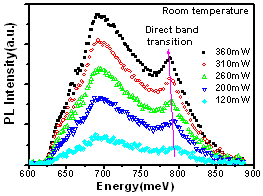 |
 |
|
Fig. 1 The PL
spectra of the Ge (100) n+p
diode at room temperature. |
Fig. 2
Temperature dependent PL at the
temperature of 310 ~ 415K. |
|
Fig. 3 The EL
spectra of the Ge (100) n+p
diode at current (a) lower than
400mA, and (b) higher than 400mA. |
|
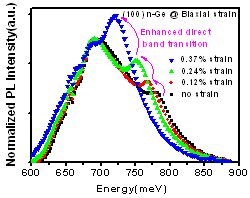 |
|
Fig. 4 PL
spectra of n-type bulk Ge (100)
under biaxial tensile strain. |
Efficient
and compact design of up-converted 435nm
blue lasers
Professor Lung-Han Peng's
group
Graduate Institute of Photonics and
Optoelectronics, National Taiwan
University
We
reported a design of up-conversion 435nm
blue lasers by simultaneously fulfilling
the nonlinear processes of 1st-order
quasi-phase-matching optical parametric
oscillation (QPM-OPO) with 2nd-order
second harmonic generation (QPM-SHG) in
a periodically poled lithium tantalate (PPLT)
at a single-period of 7.9μm and 75%
domain duty cycle (Fig.1). An optimum
PPLT device of 15 mm length, albeit
facet uncoated, exhibits a low threshold
of 150mW and a differential slope
efficiency of 22.6%, rendering a 56mW
blue generation when pumped by a pulsed
532nm green laser with an average power
rating of 400mW (Fig.2). We noted that
the transmitted green power approached
saturated values of 108 and 200 mW at
PPLT crystal lengths of 20 and 10 mm,
respectively. This phenomenon resembles
the optical power limiting effect
earlier reported on the doubly- and
singly-resonant oscillators (DRO/SRO).
In a steady state operation, it
signifies a pinning process of the
oscillator gain at a threshold value and
suggests that excess energy from the
pump beam would be transferred to the
phase-matched nonlinear optical process.
|
 |
|
Fig.1: Calculated spectral and
temperature tuning curves for the
QPM-OPO and -SHG processes in a PPLT
device of 7.9 μm
period. |
|
Fig.2: (a)
Measurement of the up-conversion
blue efficiency of a 15 mm-long PPLT
Sample B of 7.9 μm period. (Red
dashed line represents linear
fitting to the blue laser power.)
Inset: crystal length dependence of
the differential slope efficiency
for the blue lasers measured at
400mW green pump. (b) Calculated
output power of the up-conversion
blue lasers at an optical loss
Γ of 99%
and crystal length of 10, 15, and
20mm. Inset: calculated crystal
length dependence of the
differential slope efficiency for
the blue lasers at a green pump
power of 400mW. |
Glass-Clad Crystal Fibers Based
Ultrahigh Resolution Optical Coherence
Tomography
Professor
Sheng-Lung
Huang's
group
Graduate Institute of Photonics and
Optoelectronics, National Taiwan
University
Optical
coherence tomography (OCT) has evolved
as a powerful diagnostic modality for
non-invasive medical applications. With
the great success of OCT in recent
years, high resolution and high image
fidelity are getting more importance.
The axial resolution is inversely
proportional to the light bandwidth. So
far, several approaches have been
proposed to achieve high axial
resolution, such as multiplexed
superluminescent diode, femtosecond
laser, continuum generation from
photonic crystal fiber, and xenon
illuminator. In general, these solutions
either have high cost or exhibit bumpy
spectrum. In contrast, spontaneous
emission light can generate broadband
and near-Gaussian spectrum, but the
power level is often very weak. Using
waveguide to collect the amplified
spontaneous emission (ASE) can improve
brightness of the source for OCT system.
A double-clad crystal fiber (DCF) growth
technique has been developed to guide
and amplify the spontaneous emission.
Using active medium as the
single-crystalline core, the DCF can
maintain the high cross section of the
crystal environment, and effectively
collect the ASE.
By
means of the laser-heated pedestal
growth (LHPG) method, single crystalline
fibers of various active media and
diameters were first obtained from
500-μm-diameter source rods with a few
diameter-reduction steps to become 30 ~
100 μm in diameters. They were then gone
through a codrawing LHPG process to form
DCFs. During the codrawing process, the
DCF cores were further reduced to 5 to
20 μm depending on applications. At
visible wavelength range, a Ce3+:YAG
DCF generating 560-nm center wavelength
with a 3-dB bandwidth of 98 nm was
fabricated. At near IR wavelength
ranges, the active media were Ti3+:sapphire
and Cr4+:YAG for a center
wavelength of 770 nm and 1380 nm,
respectively. For Ce3+:YAG
DCF, the broadband emission and short
central wavelength of this light source
enable the realization of 1.5-μm axial
resolution in air or 1.1 μm in bio
tissues. The relatively smooth spectrum
reduced the side lobe of its point
spread function, and therefore,
facilitated the generation of a high
quality image with less crosstalk
between adjacent image pixels.
As a demonstration, an
Aplocheilus Lineatus Gold fish
was adopted to map out the stroma of its
cornea in vivo as shown in Fig.
1. The layers inside the cornea were
clearly identified. As time went on, the
cornea became thinner and more atrophic
because of water dissipation in the dry
atmosphere. This OCT system may be
useful for the detection of early stage
cornea disorders, such as Fuch’s and
keratoconus dystrophies. Active
broadband DCFs are promising for high
resolution and high image fidelity OCT
systems. Micron resolution can be
achieved with low image pixel cross
talk. These CW light sources can enable
low-cost OCT systems with cellular
resolution for various in-vivo
bio-medical applications that fulfill
the safety requirement of 20 mJ/cm2
set by US Food and Drug Administration.
|
 |
|
Fig. 1.
Goldfish cornea images of (a) full
range and (b) its partial
magnification at t=0.5 h. (b)
is the magnified figure from the dot
rectangular region of (a), where the
length of scale bar in (a) is 100 μm.
The cross-sectional image at the
same tomographic position of fish
cornea at t=0, t=0.5
h,
t=1 h, and
t=1.5 h is (c), (d), (e), and
(f), respectively. (g) is the 3D
image of oblique viewpoint at t=0.
(i) is the
en-face image inside layers
(2) and (3) of (g), whereas (h) is
the cornea surface imaged by
traditional microscope. All the
scale bars are 20 μm except for (a). |
Acknowledgment
The
authors would like to thank the support
from the National Taiwan University and
Foresight Taiwan Project Office,
National Science Council under grant
number NSC 98 2627-E-002-001.
|
|
 |
|
 |
|
| |
|
|
 |
|
 |
|
|
|